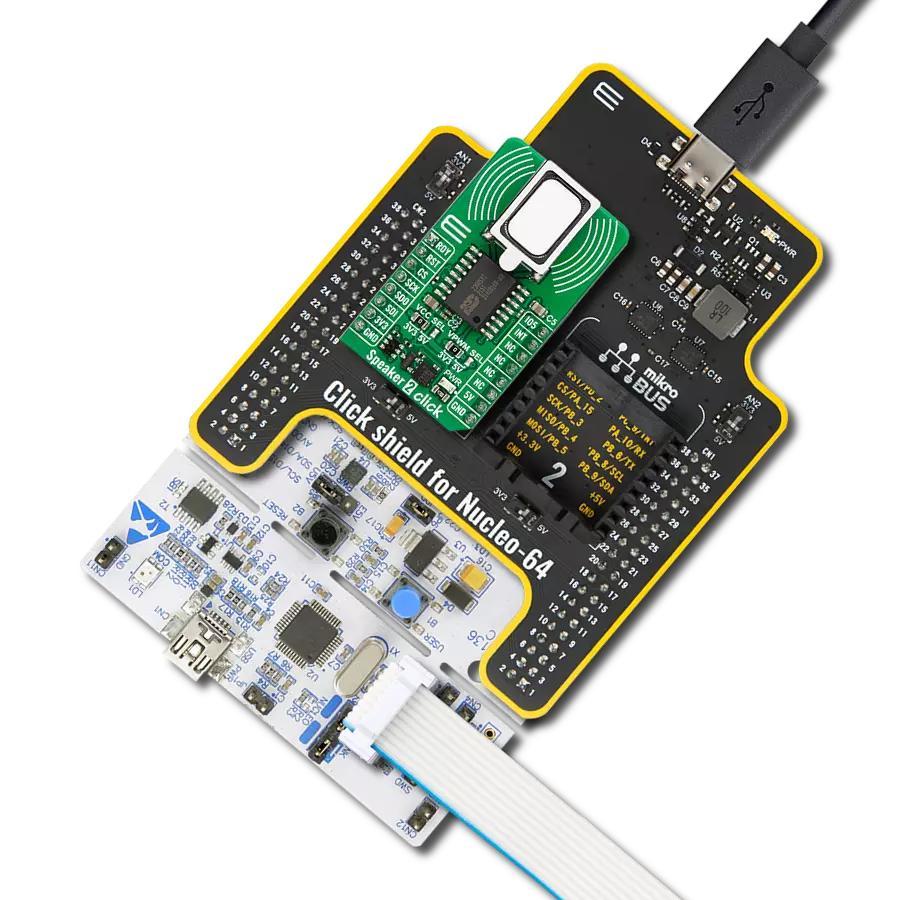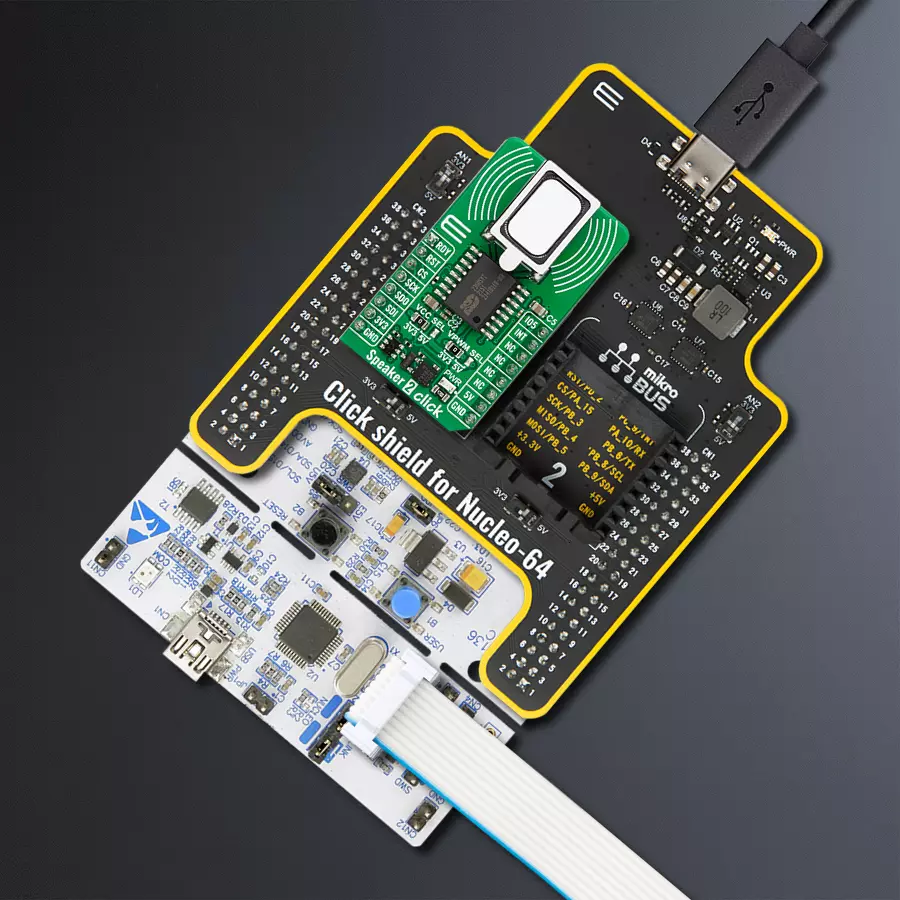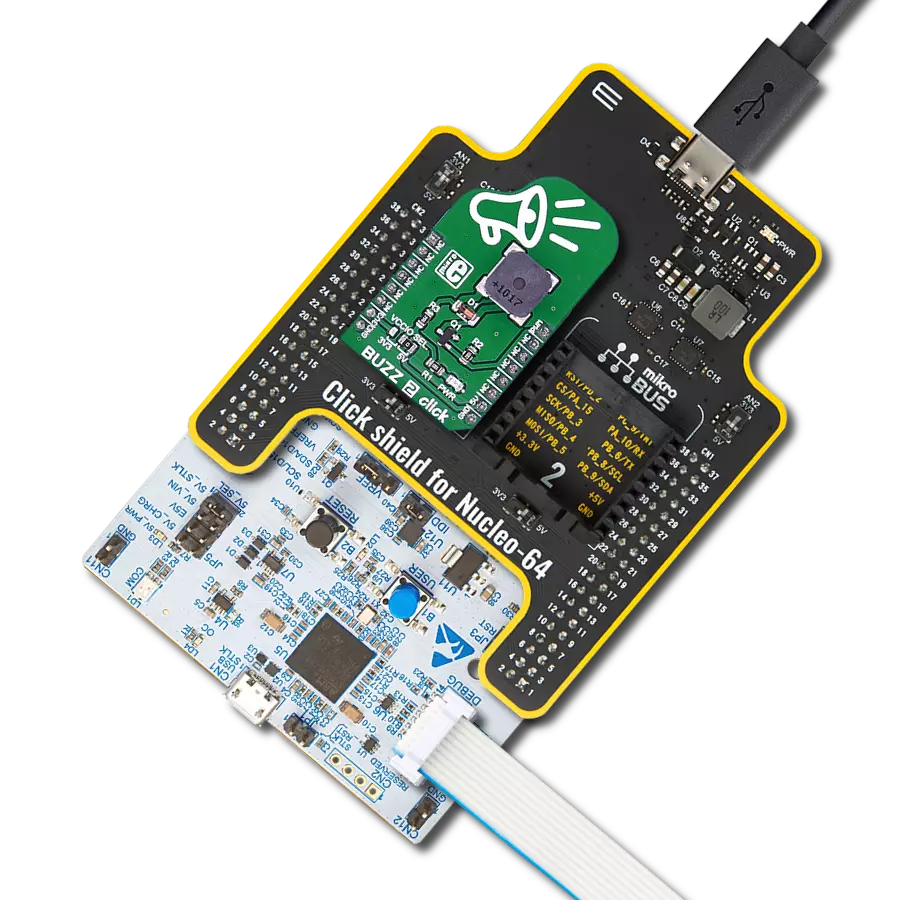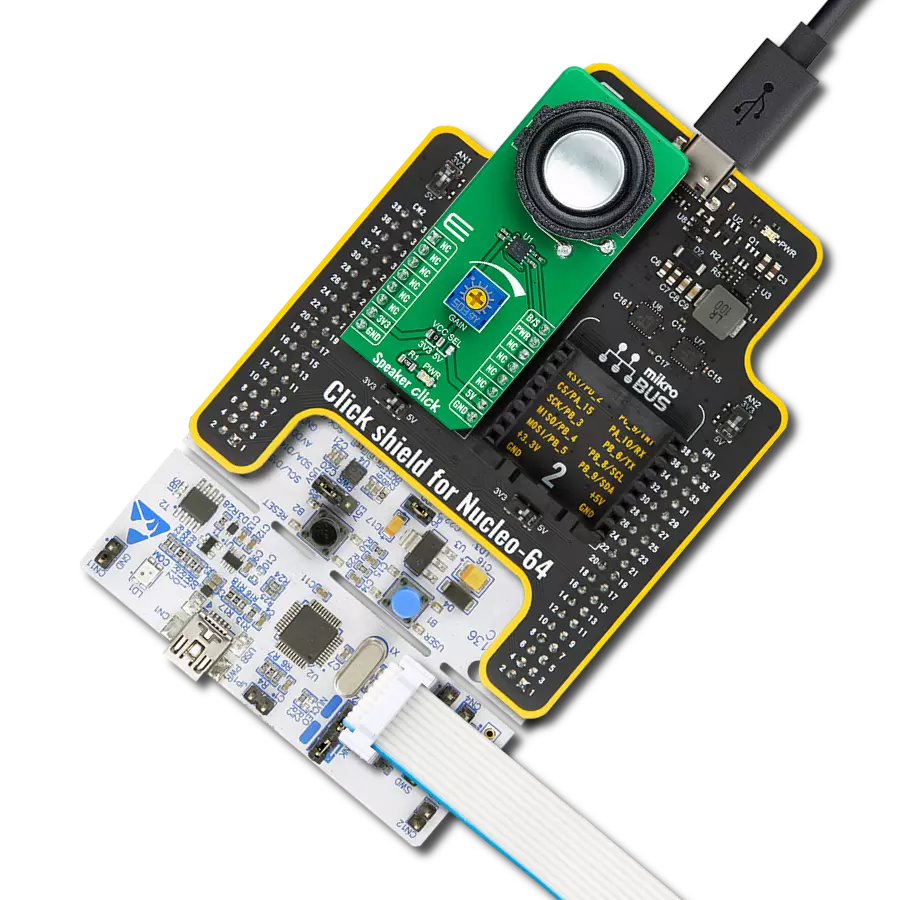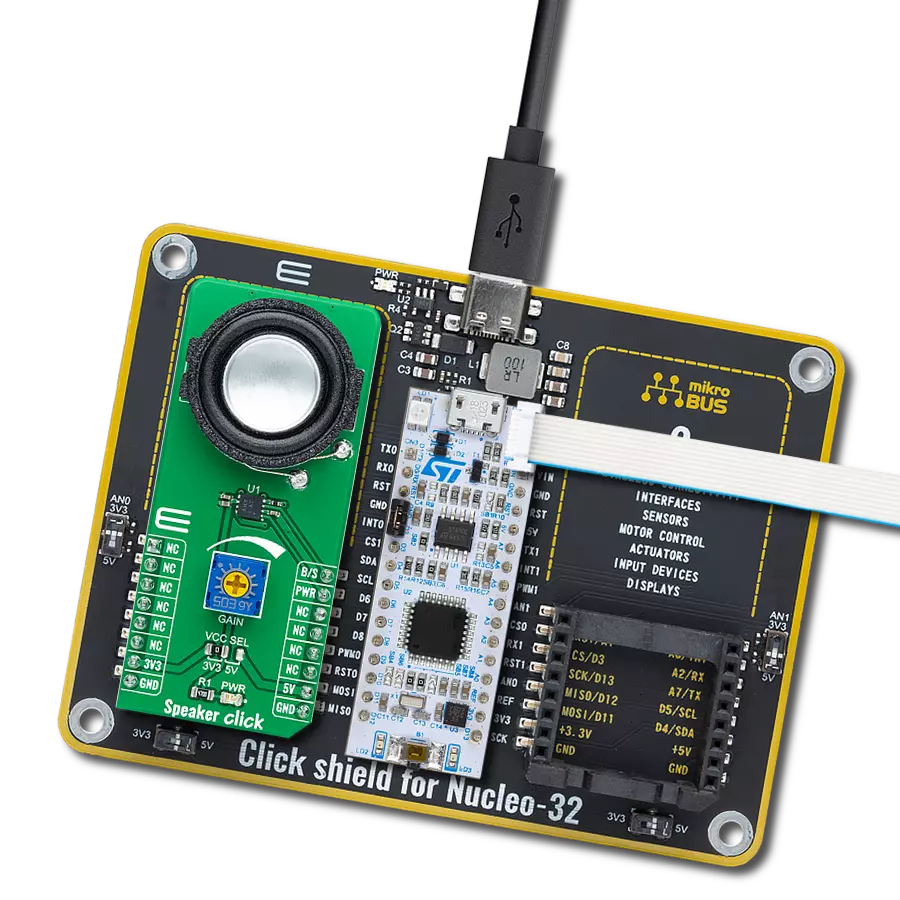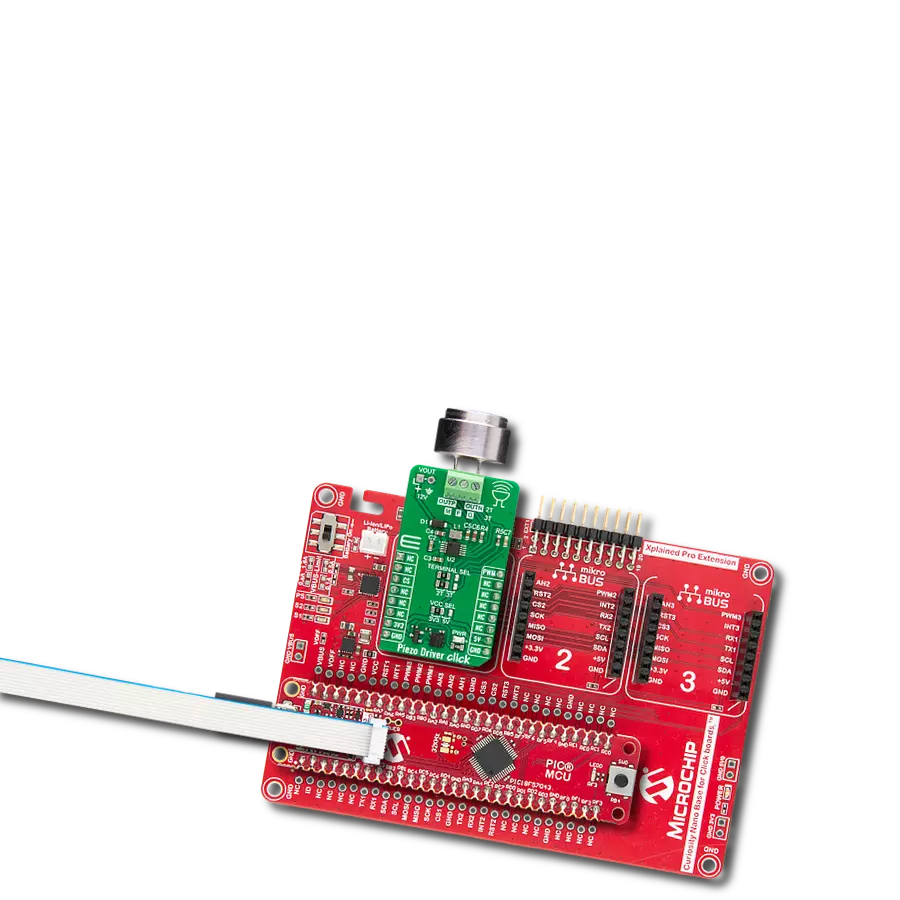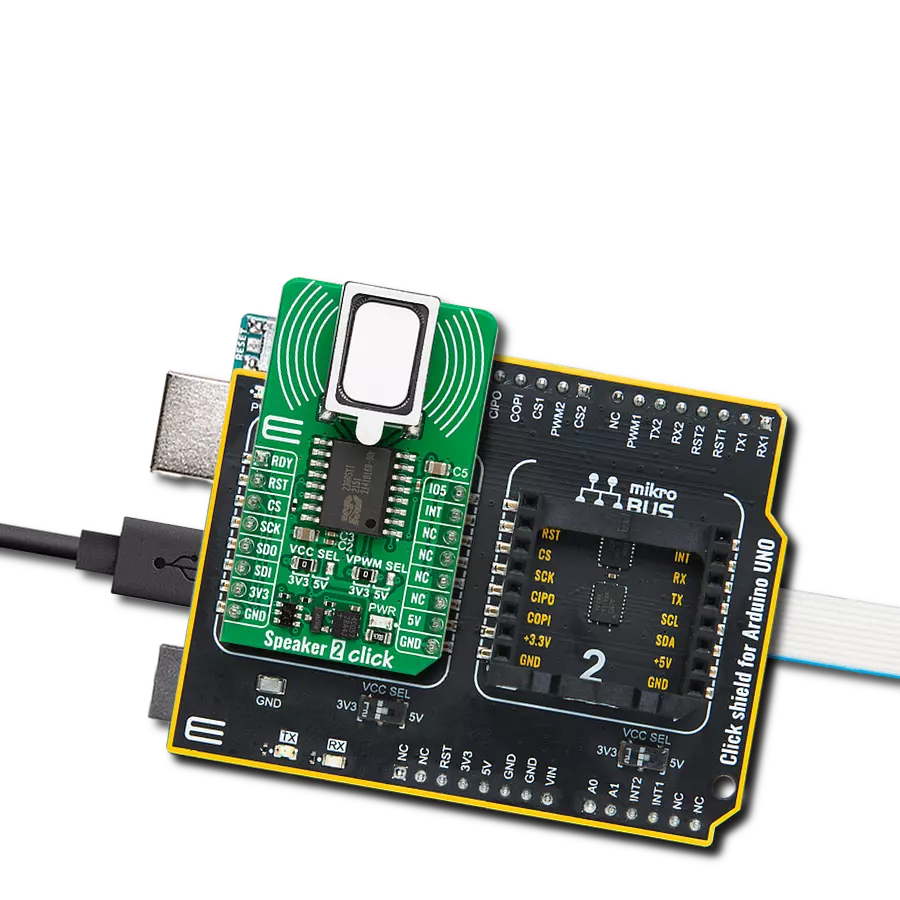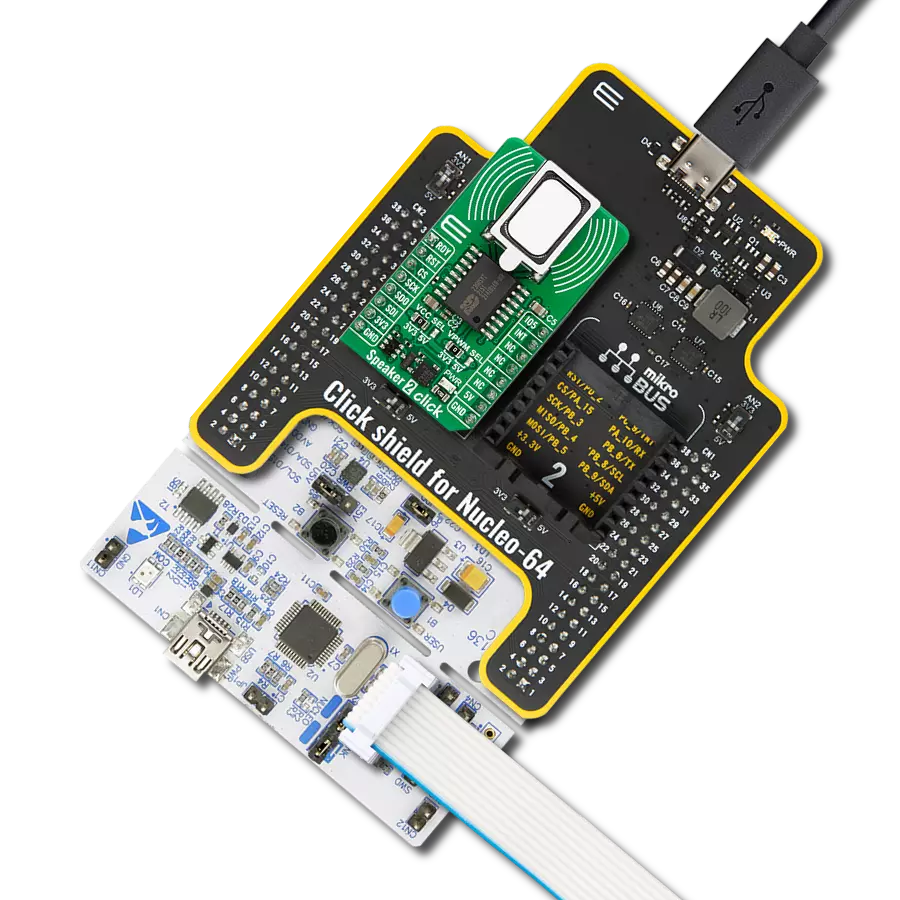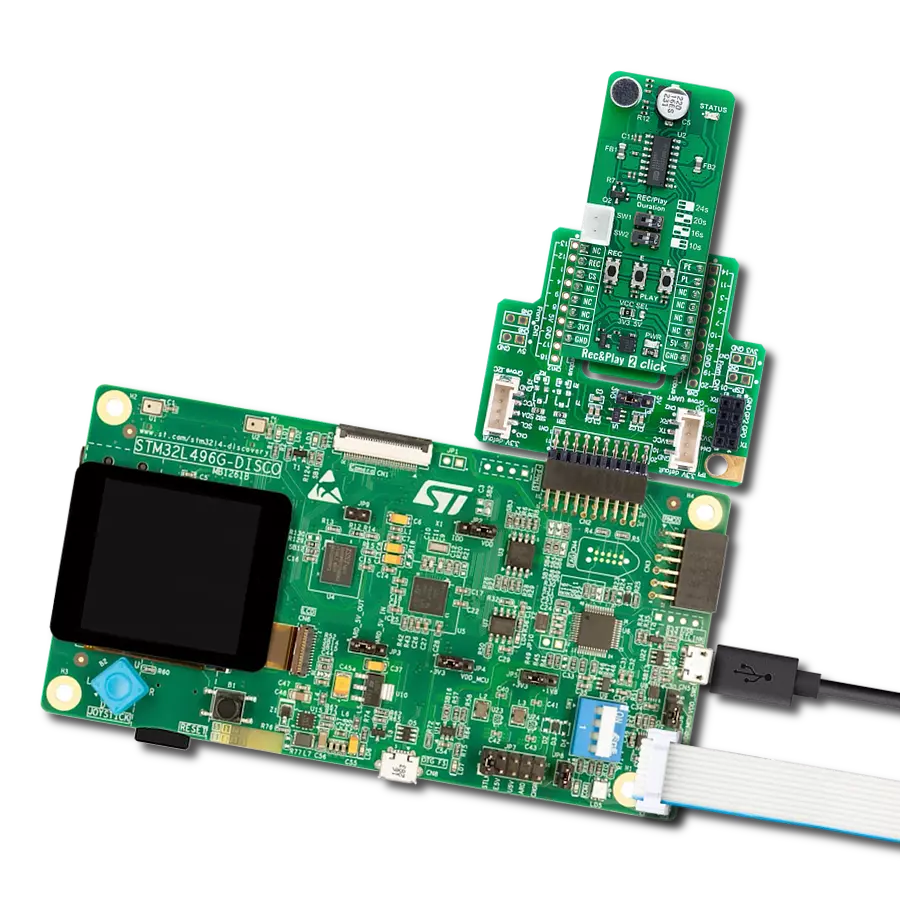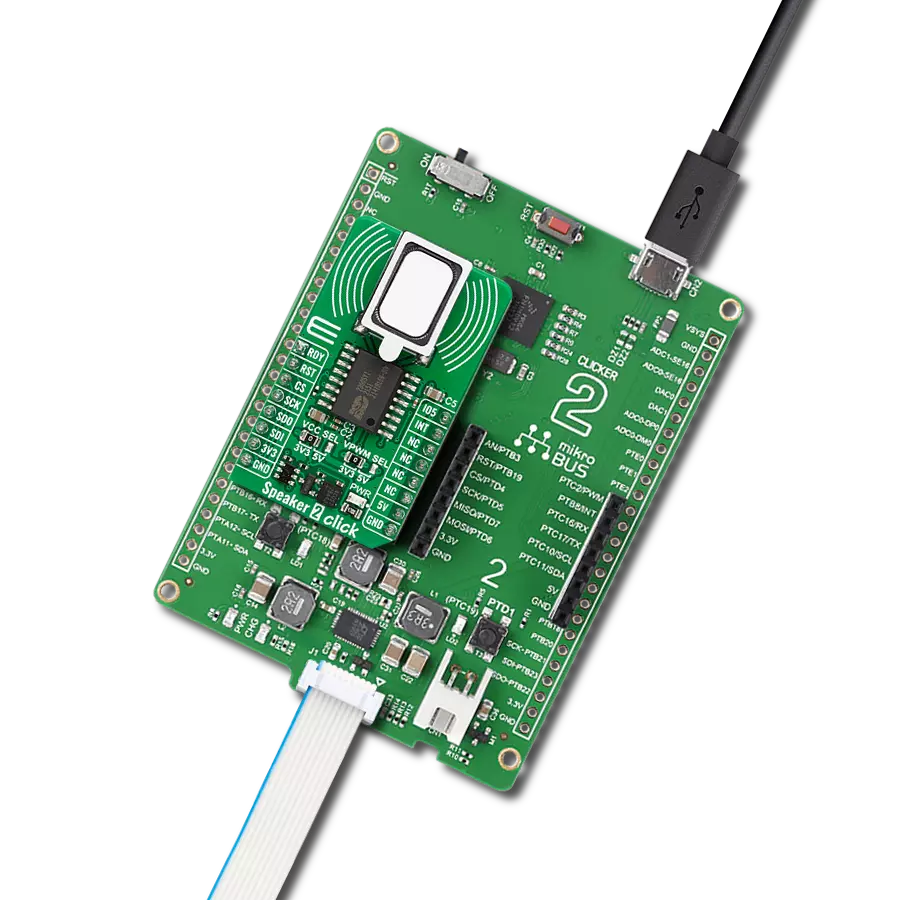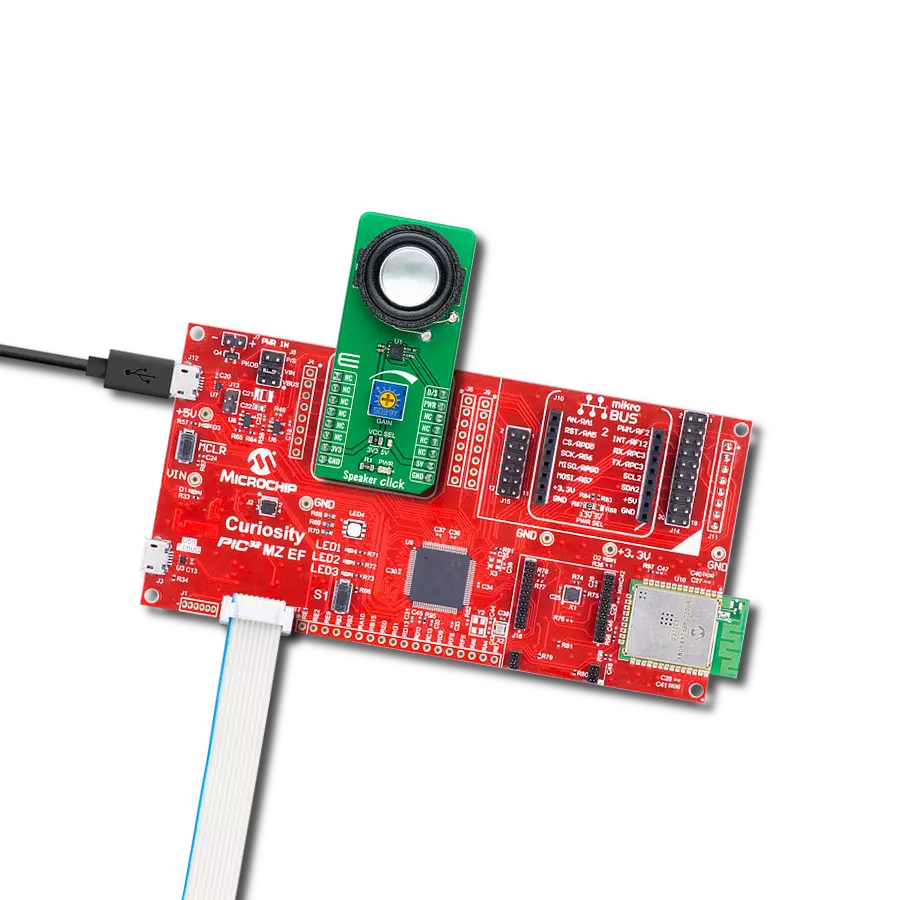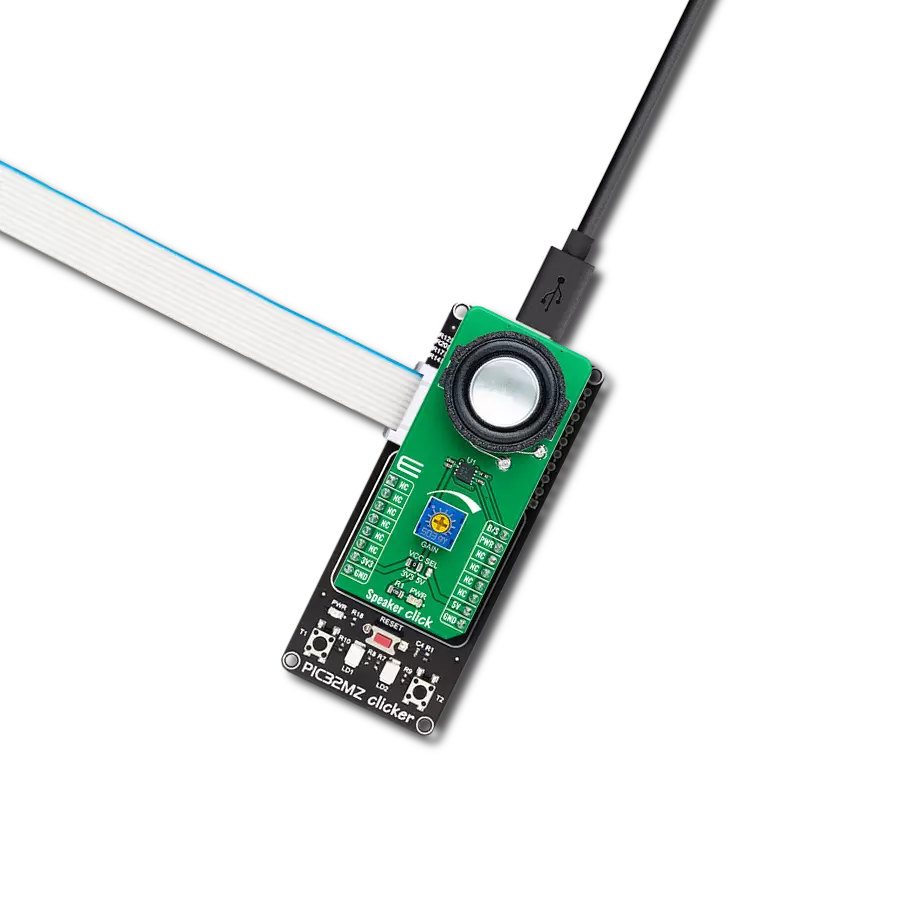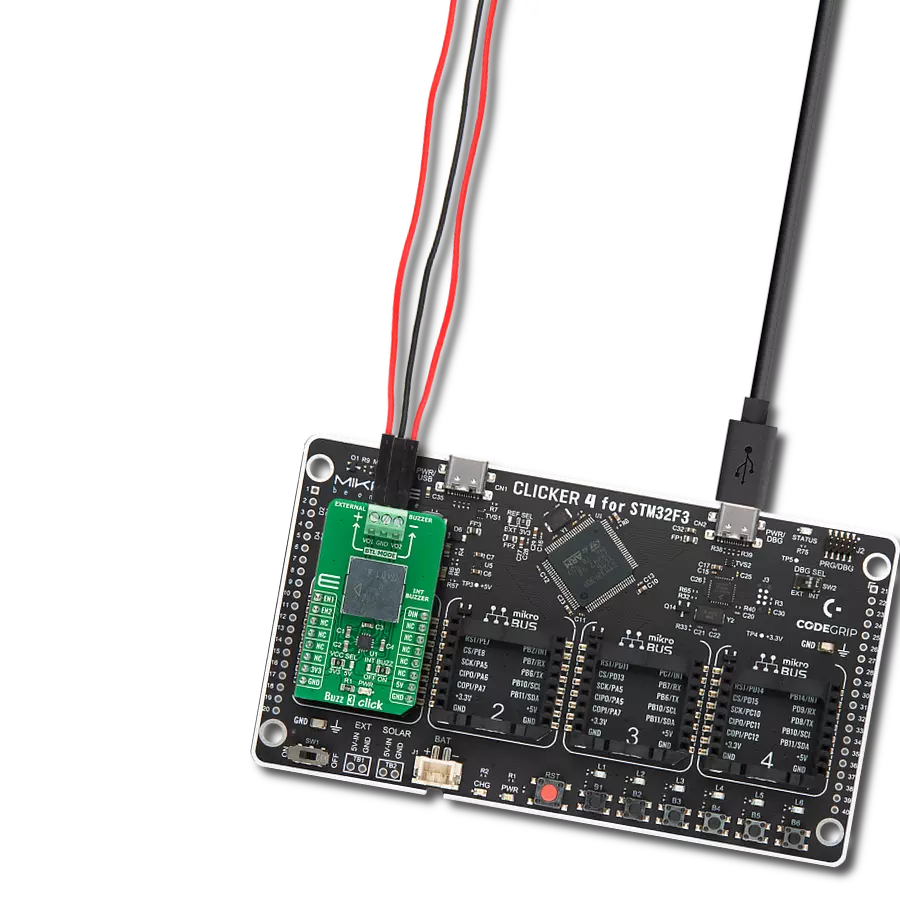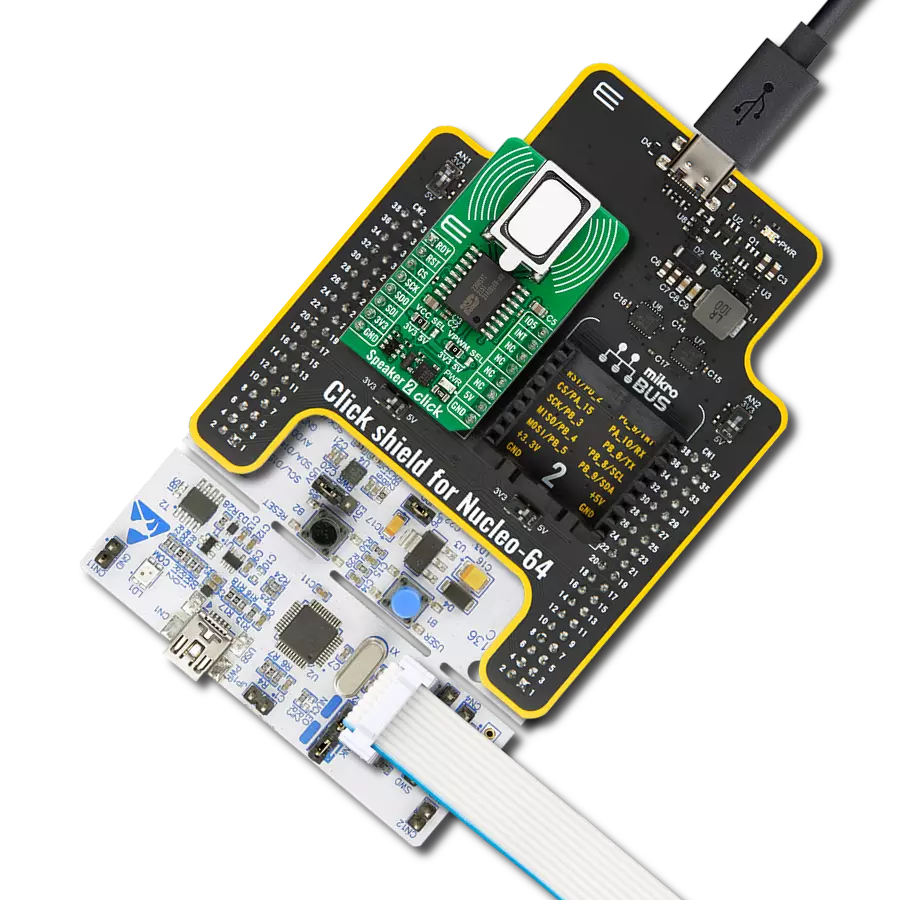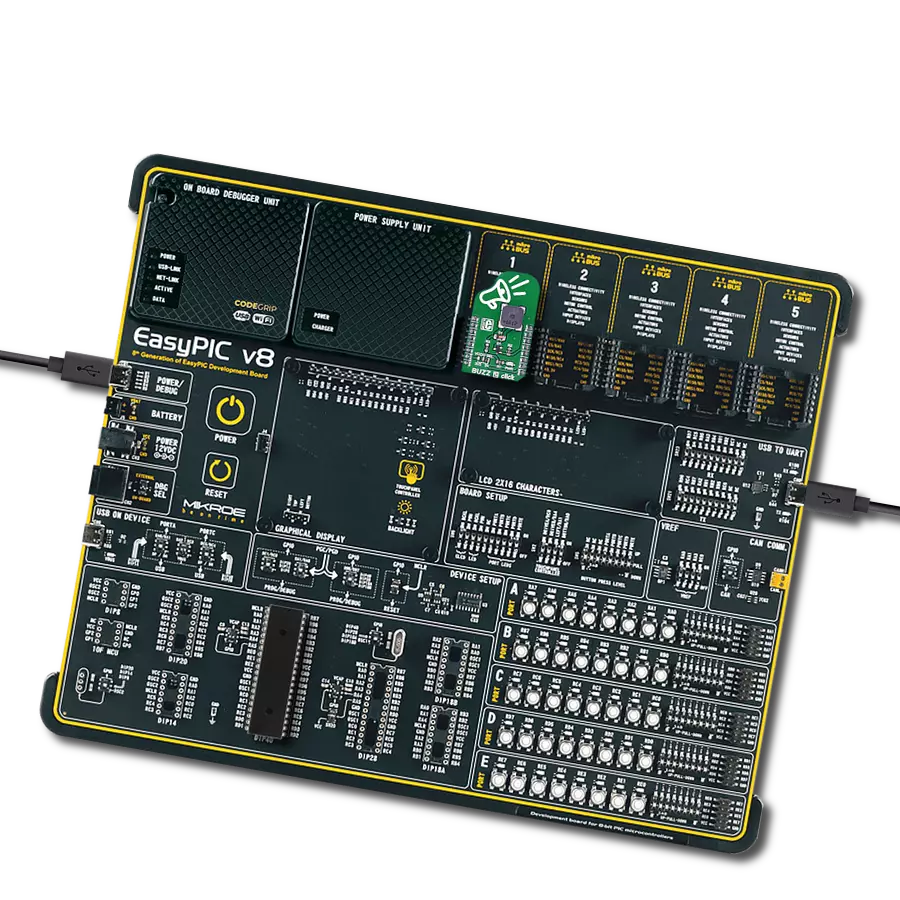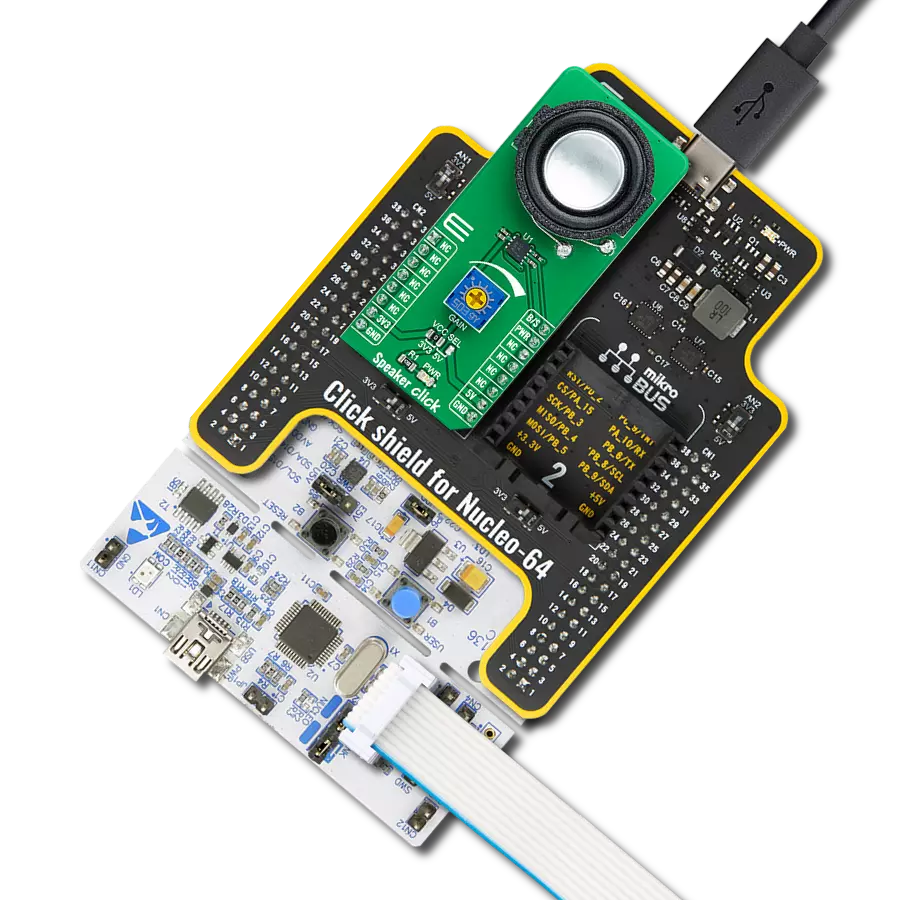Provide clear voice prompts and deliver high-quality audio playback, ideal for automation, consumer electronics, and industrial devices
A
A
Hardware Overview
How does it work?
Speaker 2 Click is based on the ISD2360, a 3-channel digital ChipCorder® from Nuvoton, designed to store and play high-quality audio using integrated flash memory. This Click board™ provides a way to manage and deliver voice prompts, sound effects, or pre-recorded audio messages, making it ideal for applications that require embedded audio playback without the complexity of external components. The ISD2360 features digital decompression, comprehensive memory management, and a fully integrated audio signal path, allowing it to handle up to three concurrent audio streams. Each playback channel operates independently, enabling precise micro-management of voice macro execution, particularly useful for complex audio sequences. With built-in flash memory, the ISD2360 provides non-volatile storage for audio playback, supporting up to 64 seconds of audio based on an 8kHz/4-bit ADPCM compression format. This eliminates the need for external memory solutions while ensuring efficient storage and high-quality audio reproduction. The device simplifies audio management by offering a straightforward method for storing pre-recorded voice prompts, using an index-based command system that does not require manual address configuration. Additionally, executing pre-programmed macro scripts (Voice Macros) enhances flexibility in controlling playback
sequences and system behavior. One of the standout features of this Click board™ is its integrated Class D speaker driver, which is optimized for driving the onboard speaker, the AS01508AO-SC-R. This allows for clear audio output without requiring additional amplification stages. The ISD2360 is designed to function without external clock sources or supplementary components. Furthermore, it includes built-in non-volatile flash storage in 1Kbyte sectors, eliminating the need for separate EEPROM or flash memory devices for storing configuration data and audio files. The ISD2360 supports various sampling frequencies, delivering excellent signal-to-noise ratio (SNR) performance while maintaining low power consumption. The fast programming time ensures quick audio storage, while the integrated program verification feature guarantees the reliability of recorded content. Speaker 2 Click communicates with the host MCU using a standard SPI interface and several other pins, which are also multiplexed with six general-purpose I/O pins, providing additional flexibility in system integration. The ISD2360 is configured by writing to dedicated configuration registers, which can be done by directly sending configuration commands over the SPI interface or executing pre-programmed Voice Macros containing configuration instructions. In addition to standard interface and control pins, the
board includes several auxiliary pins that enhance its functionality. The RDY pin serves as an output to indicate the status of data transfer on the SPI bus, where a HIGH signal means the ISD2360 is ready to receive new SPI commands or data; alternatively, it can function as a general-purpose I/O pin. The INT pin is an active-low interrupt request signal that alerts the MCU to specific events and can also be repurposed as a general-purpose I/O. Additionally, the IO5 pin provides an extra general-purpose I/O option, further expanding the board's customization potential. This Click board™ can operate with either 3.3V or 5V logic voltage levels selected via the VCC SEL jumper. This way, both 3.3V and 5V capable MCUs can use the communication lines properly. Additionally, the board features a VPWM SEL jumper, which allows for selecting the digital power supply for the PWM driver of the ISD2360 independently from the logic power supply of the Click board™ itself. This ensures greater flexibility in power management, enabling the user to optimize the board's operation based on the application's specific requirements. Also, this Click board™ comes equipped with a library containing easy-to-use functions and an example code that can be used as a reference for further development.
Features overview
Development board
Nucleo-64 with STM32F410RB MCU offers a cost-effective and adaptable platform for developers to explore new ideas and prototype their designs. This board harnesses the versatility of the STM32 microcontroller, enabling users to select the optimal balance of performance and power consumption for their projects. It accommodates the STM32 microcontroller in the LQFP64 package and includes essential components such as a user LED, which doubles as an ARDUINO® signal, alongside user and reset push-buttons, and a 32.768kHz crystal oscillator for precise timing operations. Designed with expansion and flexibility in mind, the Nucleo-64 board features an ARDUINO® Uno V3 expansion connector and ST morpho extension pin
headers, granting complete access to the STM32's I/Os for comprehensive project integration. Power supply options are adaptable, supporting ST-LINK USB VBUS or external power sources, ensuring adaptability in various development environments. The board also has an on-board ST-LINK debugger/programmer with USB re-enumeration capability, simplifying the programming and debugging process. Moreover, the board is designed to simplify advanced development with its external SMPS for efficient Vcore logic supply, support for USB Device full speed or USB SNK/UFP full speed, and built-in cryptographic features, enhancing both the power efficiency and security of projects. Additional connectivity is
provided through dedicated connectors for external SMPS experimentation, a USB connector for the ST-LINK, and a MIPI® debug connector, expanding the possibilities for hardware interfacing and experimentation. Developers will find extensive support through comprehensive free software libraries and examples, courtesy of the STM32Cube MCU Package. This, combined with compatibility with a wide array of Integrated Development Environments (IDEs), including IAR Embedded Workbench®, MDK-ARM, and STM32CubeIDE, ensures a smooth and efficient development experience, allowing users to fully leverage the capabilities of the Nucleo-64 board in their projects.
Microcontroller Overview
MCU Card / MCU
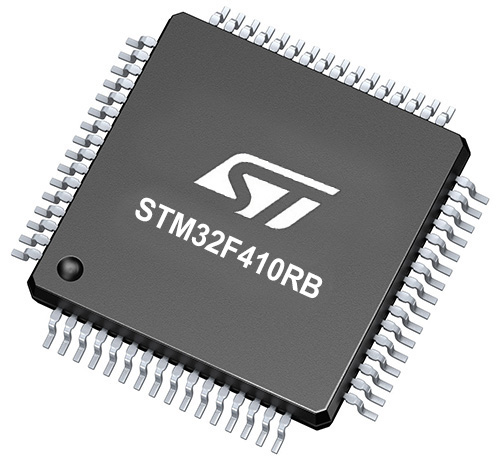
Architecture
ARM Cortex-M4
MCU Memory (KB)
128
Silicon Vendor
STMicroelectronics
Pin count
64
RAM (Bytes)
32768
You complete me!
Accessories
Click Shield for Nucleo-64 comes equipped with two proprietary mikroBUS™ sockets, allowing all the Click board™ devices to be interfaced with the STM32 Nucleo-64 board with no effort. This way, Mikroe allows its users to add any functionality from our ever-growing range of Click boards™, such as WiFi, GSM, GPS, Bluetooth, ZigBee, environmental sensors, LEDs, speech recognition, motor control, movement sensors, and many more. More than 1537 Click boards™, which can be stacked and integrated, are at your disposal. The STM32 Nucleo-64 boards are based on the microcontrollers in 64-pin packages, a 32-bit MCU with an ARM Cortex M4 processor operating at 84MHz, 512Kb Flash, and 96KB SRAM, divided into two regions where the top section represents the ST-Link/V2 debugger and programmer while the bottom section of the board is an actual development board. These boards are controlled and powered conveniently through a USB connection to program and efficiently debug the Nucleo-64 board out of the box, with an additional USB cable connected to the USB mini port on the board. Most of the STM32 microcontroller pins are brought to the IO pins on the left and right edge of the board, which are then connected to two existing mikroBUS™ sockets. This Click Shield also has several switches that perform functions such as selecting the logic levels of analog signals on mikroBUS™ sockets and selecting logic voltage levels of the mikroBUS™ sockets themselves. Besides, the user is offered the possibility of using any Click board™ with the help of existing bidirectional level-shifting voltage translators, regardless of whether the Click board™ operates at a 3.3V or 5V logic voltage level. Once you connect the STM32 Nucleo-64 board with our Click Shield for Nucleo-64, you can access hundreds of Click boards™, working with 3.3V or 5V logic voltage levels.
Used MCU Pins
mikroBUS™ mapper
Take a closer look
Click board™ Schematic

Step by step
Project assembly
Software Support
Library Description
Speaker 2 Click demo application is developed using the NECTO Studio, ensuring compatibility with mikroSDK's open-source libraries and tools. Designed for plug-and-play implementation and testing, the demo is fully compatible with all development, starter, and mikromedia boards featuring a mikroBUS™ socket.
Example Description
This example demonstrates the use of the Speaker 2 Click board. It initializes the board and plays predefined voice messages or sound effects through the speaker module. Supported voices include numbers (ONE to SIX) and sound effects like FAST BEEP.
Key functions:
speaker2_cfg_setup- Config Object Initialization function.speaker2_init- Initialization function.speaker2_default_cfg- Click Default Configuration function.speaker2_play_voice- This function plays a voice at the specified index.speaker2_play_macro- This function executes a macro command at the specified index.speaker2_play_voice_loop- This function plays a voice in a loop for a specified number of iterations.
Application Init
Initializes the logger module, configures the Speaker 2 Click board, and applies the default settings to reset the device, power it up, verify communication, and load an example audio project into the device memory.
Application Task
Sequentially plays predefined voice messages and sound effects from the Speaker 2 Click board while logging the playback status (DONE or ERROR) for each sound.
Open Source
Code example
The complete application code and a ready-to-use project are available through the NECTO Studio Package Manager for direct installation in the NECTO Studio. The application code can also be found on the MIKROE GitHub account.
/*!
* @file main.c
* @brief Speaker 2 Click example
*
* # Description
* This example demonstrates the use of the Speaker 2 Click board. It initializes the board
* and plays predefined voice messages or sound effects through the speaker module.
* Supported voices include numbers (ONE to SIX) and sound effects like FAST BEEP.
*
* The demo application is composed of two sections:
*
* ## Application Init
* Initializes the logger module, configures the Speaker 2 Click board, and applies the
* default settings to reset the device, power it up, verify communication, and load an example
* audio project into the device memory.
*
* ## Application Task
* Sequentially plays predefined voice messages and sound effects from the Speaker 2 Click board
* while logging the playback status (DONE or ERROR) for each sound.
*
* @author Stefan Filipovic
*
*/
#include "board.h"
#include "log.h"
#include "speaker2.h"
static speaker2_t speaker2;
static log_t logger;
void application_init ( void )
{
log_cfg_t log_cfg; /**< Logger config object. */
speaker2_cfg_t speaker2_cfg; /**< Click config object. */
/**
* Logger initialization.
* Default baud rate: 115200
* Default log level: LOG_LEVEL_DEBUG
* @note If USB_UART_RX and USB_UART_TX
* are defined as HAL_PIN_NC, you will
* need to define them manually for log to work.
* See @b LOG_MAP_USB_UART macro definition for detailed explanation.
*/
LOG_MAP_USB_UART( log_cfg );
log_init( &logger, &log_cfg );
log_info( &logger, " Application Init " );
// Click initialization.
speaker2_cfg_setup( &speaker2_cfg );
SPEAKER2_MAP_MIKROBUS( speaker2_cfg, MIKROBUS_1 );
if ( SPI_MASTER_ERROR == speaker2_init( &speaker2, &speaker2_cfg ) )
{
log_error( &logger, " Communication init." );
for ( ; ; );
}
if ( SPEAKER2_ERROR == speaker2_default_cfg ( &speaker2 ) )
{
log_error( &logger, " Default configuration." );
for ( ; ; );
}
log_info( &logger, " Application Task " );
}
void application_task ( void )
{
log_printf ( &logger, " Playing voice ONE: %s\r\n\n", ( char * )
( ( SPEAKER2_OK == speaker2_play_voice ( &speaker2, SPEAKER2_VP9_ONE ) ) ? "DONE" : "ERROR" ) );
log_printf ( &logger, " Playing voice TWO: %s\r\n\n", ( char * )
( ( SPEAKER2_OK == speaker2_play_voice ( &speaker2, SPEAKER2_VP10_TWO ) ) ? "DONE" : "ERROR" ) );
log_printf ( &logger, " Playing voice THREE: %s\r\n\n", ( char * )
( ( SPEAKER2_OK == speaker2_play_voice ( &speaker2, SPEAKER2_VP11_THREE ) ) ? "DONE" : "ERROR" ) );
log_printf ( &logger, " Playing voice FOUR: %s\r\n\n", ( char * )
( ( SPEAKER2_OK == speaker2_play_voice ( &speaker2, SPEAKER2_VP12_FOUR ) ) ? "DONE" : "ERROR" ) );
log_printf ( &logger, " Playing voice FIVE: %s\r\n\n", ( char * )
( ( SPEAKER2_OK == speaker2_play_voice ( &speaker2, SPEAKER2_VP13_FIVE ) ) ? "DONE" : "ERROR" ) );
log_printf ( &logger, " Playing voice SIX: %s\r\n\n", ( char * )
( ( SPEAKER2_OK == speaker2_play_voice ( &speaker2, SPEAKER2_VP14_SIX ) ) ? "DONE" : "ERROR" ) );
log_printf ( &logger, " Playing voice FAST BEEP: %s\r\n\n", ( char * )
( ( SPEAKER2_OK == speaker2_play_voice ( &speaker2, SPEAKER2_VP15_FAST_BEEP ) ) ? "DONE" : "ERROR" ) );
}
int main ( void )
{
/* Do not remove this line or clock might not be set correctly. */
#ifdef PREINIT_SUPPORTED
preinit();
#endif
application_init( );
for ( ; ; )
{
application_task( );
}
return 0;
}
// ------------------------------------------------------------------------ END
Additional Support
Resources
Category:Speakers
